ROSES AND STRAWBERRIES AND — OH NO! — HONEYBERRIES
Roses, Oh Yes
I bake really good bread, but “man can’t live by bread alone.” Sometimes, you’ve got to “stop to smell the roses.” Enough with the quotations! But back to the roses.
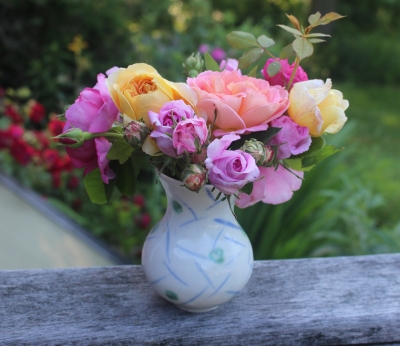
A love of roses has crept up on me over the years, due mostly to changes in kinds of roses available. Up until about 30 years ago, hybrid teas were pretty much the only roses on the block. These plants’ gangly stems are each capped by a vividly colored, fairly stiff, formal blossom whose petals wrap together into a pointy peak. You see where I’m going: hybrid teas are ugly, to me at least.
Also available were grandiflora and floribunda roses. Grandifloras are like hybrid teas, except their stems end with clusters of a few, but smaller, blossoms. Floribunda roses have even larger flower clusters of even smaller flowers. Despite being bushes more full with flowers than hybrid teas, grandiflora and floribunda flowers are still rather prim and proper except for their traffic-stopping colors.
Then so-called species and old-fashioned roses entered the scene, roses that are as nature made them or only slightly hybridized. These roses constitute broad groups, but generally, what they have going for them are more subdued — think pastel — colors and more blowsy blossoms on more heavily branching, fuller-bodied, shrubs.
The downside to species and old-fashioned roses, even if you like their blossoms and their growth habits, is that many bloom only in the spring. Hybrid teas pump out blossom after blossom all summer long.
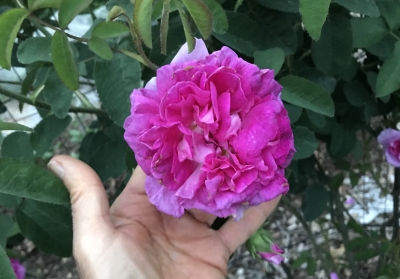
Rose d’Ipsahan
Enter Rose de Rescht, my first old-fashioned rose, given to me by a local, fellow gardener. Ann told me that this rose variety had soft pink flowers and heavenly scent. She was right about the appearance and fragrance, wrong about the name. After years of sleuthing, I’ve identified the rose as Rose d’Ispahan, probably originating in Persia but first discovered in a garden in Isfahan, Iran, renowned for its gardens and roses.
If I had to grow only one variety of rose, Rose d’Ispahan would be the one, for the beauty of its flowers, for its intense fragrance, for its cold-hardiness, for its lack of large thorns, and for its pest resistance. And that’s even though it blossoms only in spring. (It does so over a long period, though.)
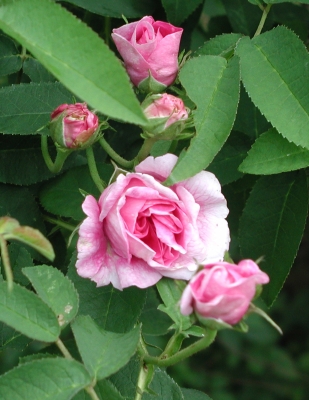
Rose d’Ipsahan
But I don’t have to grow only one variety of rose. My other favorites are some of rose breeder David Austin’s varieties which combine the pest resistance and repeat blooming of modern roses with the blowsy, fragrant, pastel colored blossoms and full-bodied shrubs of old fashioned roses. My currant, and perhaps all-time, favorites are Lady of Shallot and, in my opinion needing a more euphonious name, Golden Celebration.
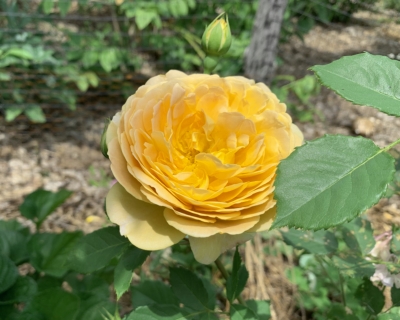
Golden Celebration rose
Both sport yellow — no, Golden! — blossoms, some apricot in those of Lady of Shallot, and a rich yellow, all contained in a petal-filled cup-shape in those of Golden Celebration. Another of my favorites, Lady Judi Dench, never woke up in spring a year ago; perhaps it was the cold, perhaps something else.
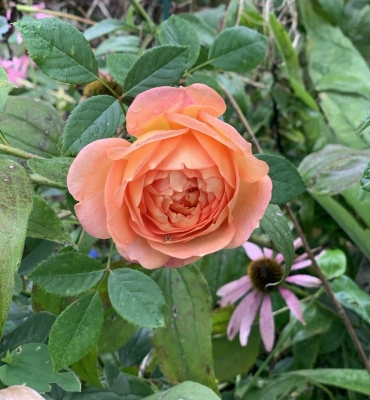
Lady of Shallot rose
I also grow another David Austin Rose, LD Braithewaite, with deep red blossoms and dark green, slightly reddish leaves. Not my favorite as far as appearance but this rose is very cold hardy and pumps out tons of blossoms almost all season long.
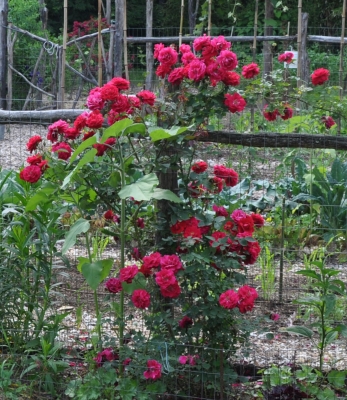
LD Braithewaite rose
And Strawberries, Oh Yes
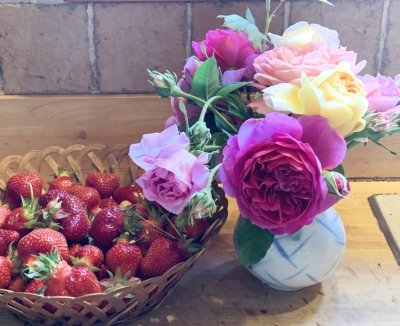 On to strawberries. I’m growing three kinds: the Pineapple Crush variety of white alpine strawberries; the Earliglow variety of garden strawberry; and a few varieties of vescana strawberries, which are hybrids of garden and alpine strawberries. This also is the order, starting with the best, of flavor for the three types.
On to strawberries. I’m growing three kinds: the Pineapple Crush variety of white alpine strawberries; the Earliglow variety of garden strawberry; and a few varieties of vescana strawberries, which are hybrids of garden and alpine strawberries. This also is the order, starting with the best, of flavor for the three types.
Why do I grow anything but the best? Because alpines are so small that it’s hard to fill a bowl with them. I grow vescanas, for the first time this year, because I never grew them before.
The Earliglow berries taste good and do quickly fill a bowl, ideally yielding one quart of berries per plant over the course of the season. Except this year, a problem has surfaced. Leather rot is a fungal disease (Phytophthora cactorum) that rears its ugly head — infected berries that taste bitter and have white patches that turn brown — usually following excessively wet periods from late spring to early summer, which is odd because weather has been on the dry side. Also odd because I’ve never seen the problem here before.
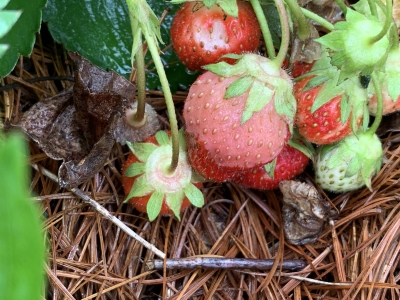
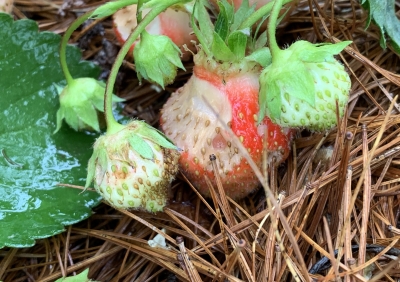
Which brings me back to vescana and Pineapple Crush. Both are very disease resistant, and vescana berries are almost as big as garden strawberries, so I’m thankful to have them, even if they do taste like canned strawberries.
And Honeyberries, Oh NO!
After three weeks of hanging on (the berries, not me), honeyberries, which are edible honeysuckles, are ready for a fair tasting. I wrote previously about the awful flavor of this new fruit and was instructed to let the berries hang till dead ripe.

The berries sampled this year were so ripe that each had to be plucked from the branch with my palm facing upwards beneath the berry; a mere touch would cause ripe ones to drop.
Rat-a-tat-tat-tat-tat (a drum roll). First to be tasted was the variety Solo. Reaction: spit it out quickly. Tart with bad flavor. Second fruit tasted was Sugar Mountain Blue. Also spit out, but not quite as quickly. And finally, Sugar Mountain Eisbär. Although retained in the mouth and having a hint of sweetness, this one, like the others, had bad flavor.
The flavor of honeyberries is allegedly like a mix of blueberry and raspberry. Not so! If you have space, plant blueberries or raspberries instead.

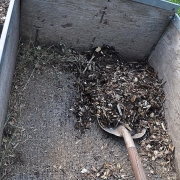
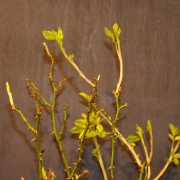

Lee:
All sounds great but how do you protect all your garden from the “outside ventures”,animals and things like that. I have a habitat of…squirrels,deer,ground hogs, cute little bunnies and what ever is out there for a free dinner. I do not have any animals like i had in the past.
Mayby I should just stay inside and paint pictures.
It looks like you are having a good season. Keep up the good work.
Ken
Dogs, cats, some fencing, traps.
Ken, I feel your pain. I am overrun with chipmunks and I spent almost $900 on electric net fencing. Does great with deer etc., but ‘munks go right around. I have beautiful strawberries and have never tasted 1 berry in 3 years trying. I shot 13 of them last year when we had a mast year of acorns. They are just as plentiful this year. DARN.
The University of Saskatoon (Saskatchewan) has a breeding program for haskaps that has produced interesting edible varieties. Cinderella, Boreal, Indigo Gem, Tundra are a few of the older varieties that I have grown. Tart and flavourful taste that even flocks of cedar wax wings find popular. Harsh cold and high moisture are conditions that have not yet hurt them in my zone 2 garden. Newer Saskatchewan varieties are said to be even more flavourful and bigger.
I’m going to have to wait a few years before again devoting any space to any honeyberries.
Funny about the bad taste. I grow a few Boreal and Tundra and blueberries and actually think the haskaps taste better than blueberries.
Where are you? In some far northern region? Where cold limits what people can grow, it also extends their judgement of what tastes good. Oh well, I guess I’m going to have to try one of those varieties.
For what it’s worth, about half the people I give honeyberries to love them, the other half react exactly like you — Maxie and Solo in z6b. I wouldn’t plant a whole row but I love having a few for some early nibbles several weeks before my earliest blueberries.
The folks that like then also like really tart sour cherries and are ok eating not quite ripe blueberries.
I pick them early — they are more tart then but also more flavor and firmer.
I grow cornelian cherries which I don’t really like. They have lots of eye appeal so I give out a lot of tastes and everyone tries them. To me, they’re sour, with a bad flavor. But about 60% of the people that try them like them. Different strokes for different folks.
Oh! That’s good to know — I’ve been afraid to plant them because of that reputation, but if their purported sourness is in the same family… Makes it more likely I’m in that 60%. Now all I need to do is find a place to put more plants!
I have this wild irish rose bush that comes back every year even after lawn mower accidents and grandkids. Never thought much on roses but im gonna pay more attention to this one cuz the flowers are pretty and smell nice. Thanks again for a great article and reminder that even inedible plants are worth it.
Hi Lee,
I loved your accounting of these rose varieties. You are 4 hours north of me. I live near Rutland, VT, and wonder if l’Ipsahan, Golden Celebration, Lady of Shallot and Braithwaite varieties would survive here. I’m in a chilly zone 4, always at least 5 degrees colder than Rutland, 10 miles away.
I grew up in SE PA where I think I recall Blaze rose, red, sprawling all over a neighbor’s fence. I wonder if it would grow here.
I’m four hours SOUTH of you. I’m in the colder part of zone 5 so the roses might work for you. Many of them are not grafted; the roots will survive and they’ll then bear those beautiful blossoms on new growth from ground level, just a little later in the season.
Always with the blueberries and raspberries, I am going to quit strawberries.
The roses are lovely! I also tried a few varieties of honeyberry with similar results (I’m in the mid-Atlantic). They barely sweetened up, and even the ones that weren’t puckeringly tart had poor flavor. I didn’t notice whether the birds ate the fruit, but I pulled the bushes out before they got very large. Maybe they’d have been popular with the wildlife if they had been more abundant.
I guess some people like the, and some — you and I, for instance — don’t.
Interested to hear more about what you companion plant with your roses. We currently have a thrips problem and are failing to attract pirate bugs so far, which eat thrips…
My roses rarely have enough problems to have to deal with them. I have too many other plants to deal with to address problems if they had them. If they don’t do well, I’ll rip them out, if I get around to it.
You’ve turned me on to blueberries years ago! Record moisture in fall and spring have brought the biggest crop ever of early southern highbush berries despite encroaching shade. But berries have watery flavor, haven’t ripened fully after 10 days at nearly ripe, and drop before fully ripe. Flavor is disappointing. Nothing to do I suppose. I’m NE of Raleigh NC, warm side of Zone 7b. Comments?
Perhaps you’ve just ended up with inherently poor-tasting varieties. I’ve never tasted the southern highbush varieties but would expect them to have good flavor. The ideal would be to find somewhere you could taste some other varieties. A local other grower? Hoigh rainfall has never ruiined the flavor of my blueberries.
We all are motivated by a personal hierarchy of food priorities – cost, taste, nutrition, local, organic, sustainable, etc. For you, Lee, taste scores high on your list. Highest on my list are foods that are nutrient dense and thus I grow every berry I can. Honeyberries grow well for me in Central Indiana. I think they taste great when fully ripe. My most successful, consistent, and easy crop is elderberries. I eat them every day. Taste is subjective, nutrition is objective. And I’m not a curmudgeon who punishes herself – I like my colorful, fresh, homegrown diet. It all tastes great to me! Please don’t discourage people from growing healthy food because you think it tastes bad.
Good point. If it wasn’t clear, yes, taste is subjective, and I was expressing my opinion of the taste. I’d be interested in how others feel about the flavor of honeyberries and elderberries. (I am going to try some other varieties of honeyberries.) For the record, I also don’t like the tste of parsnips and jerusalem artichokes.